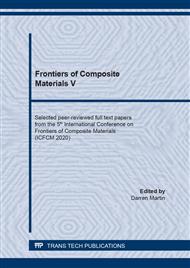[1]
P. Beulah, U. Jinu, M. Ghorbanpour and P. Venkatachalam, Chapter 14 - Green Engineered Chitosan Nanoparticles and Its Biomedical Applications—An Overview,, in Advances in Phytonanotechnology From Synthesis to Application, Cambridge, Academic Press, 2019, pp.329-341.
DOI: 10.1016/b978-0-12-815322-2.00015-8
Google Scholar
[2]
L. M. Pinzón, F. J. Cedano, C. I. Castro, J. C. Briceño, J. P. Casas, D. M. Tabima and F. Salcedo, Formulation and characterization of chitosan-based biocomposites with potential use for bone adhesion,, International Journal of Polymeric Materials and Polymeric Biomaterials, pp.697-707, (2017).
DOI: 10.1080/00914037.2016.1263948
Google Scholar
[3]
D. . K. Rajak, D. D. Pagar, P. L. Menezes and E. Linul, Fiber-Reinforced Polymer Composites: Manufacturing, Properties, and Applications,, Polymers, p.1667, (2019).
DOI: 10.3390/polym11101667
Google Scholar
[4]
J. Lai, Y. Yi, P. Zhu, J. Shen, . K. Wu, L. Zhang and J. Liu, Polyaniline-based glucose biosensor: A review,, Journal of Electroanalytical Chemistry, pp.138-153, (2016).
DOI: 10.1016/j.jelechem.2016.10.033
Google Scholar
[5]
T. Alvez, J. Souza, V. Amaral, D. Almeida , D. Grotto, R. Lima , N. Aranha, L. S. Filho , J. J. Oliveira , C. Barros, P. Severino, A. Souza and M. Chaud, Biomimetic dense lamellar scaffold based on a colloidal complex of the polyaniline (PANi) and biopolymers for electroactive and physiomechanical stimulation of the myocardial,, Colloids and Surfaces A, p.123650, (2019).
DOI: 10.1016/j.colsurfa.2019.123650
Google Scholar
[6]
A. Soni, C. M. Pandey and S. Solanki, Synthesis of 3D-coral like polyaniline nanostructures using reactive oxide templates and their high performance for ultrasensitive detection of blood cancer,, Sensors & Actuators: B. Chemical, pp.634-642, (2019).
DOI: 10.1016/j.snb.2018.10.126
Google Scholar
[7]
D. Shi, Introduction to Biomaterials, Beijing: Tsinghua University Press, (2005).
Google Scholar
[8]
J. Jumalon, Fabrication of Polyaniline-Polyvinyl alcohol-chitosan hydrogels and effects of gamma irradiation,, University of the Philippines - Manila, Manila City, (2019).
Google Scholar
[9]
B. R. Pasela, A. P. T. Castillo, R. Simon, M. T. Pulido, H. Mana-ay, M. R. Abiquibil, R. Montecillo, K. Thumanu, D. v. C. Tumacder and K. L. M. Taaca, Synthesis and Characterization of Acetic Acid-Doped Polyaniline and Polyaniline–Chitosan Composite,, Biomimetics, p.15, (2019).
DOI: 10.3390/biomimetics4010015
Google Scholar
[10]
A. G. Yavuz , A. Uygun and V. R. Bhethanabotla, Substituted polyaniline/chitosan composites: Synthesis and characterization,, Carbohydrate Polymers , p.448–455, (2009).
DOI: 10.1016/j.carbpol.2008.08.005
Google Scholar
[11]
Compound Summary: Acetic Acid,, 2020. [Online]. Available: https://pubchem.ncbi.nlm.nih.gov/compound/Acetic-acid.
Google Scholar
[12]
W. Wang, M. Li, W. Fang, A. Pradhan and Y. Li, A predictive model for assessment of decontamination effects of lactic acid and chitosan used in combination on Vibrio parahaemolyticus in shrimps.,, International Journal of Food Microbiology, pp.124-130, (2013).
DOI: 10.1016/j.ijfoodmicro.2013.07.012
Google Scholar
[13]
N. Niamsa and Y. Baimark, Preparation and Characterization of Highly Flexible Chitosan Films for Use as Food Packaging,, American Journal of Food Technology, pp.162-169, (2009).
DOI: 10.3923/ajft.2009.162.169
Google Scholar
[14]
A. Madni, R. Khan, M. Ikram , S. S. Naz, T. Khan and F. Wahid, Fabrication and Characterization of Chitosan–Vitamin C–Lactic Acid Composite Membrane for Potential Skin Tissue Engineering,, International Journal of Polymer Science, (2019).
DOI: 10.1155/2019/4362395
Google Scholar
[15]
D. Zvezdova, Synthesis and characterization of chitosan from marine sources in Black Sea,, vol. 49, pp.65-69, (2010).
Google Scholar
[16]
S. Ahmed and S. Ikram, Chitosan: Derivatives, Composites and Applications,, in Technology and Engineering, Wiley, (2017).
Google Scholar
[17]
A.A. Mahmoud, O. Osman, K. Eid, E. Al Ashkar, A. Okasha, D. Atta, M. Eid, Z. A. Aziz and A. Fakhry, FTIR Spectroscopy of Natural Bio-Polymers Blends,, Middle East Journal of Applied Sciences, vol. 4, no. 4, pp.816-824, (2014).
Google Scholar
[18]
L. Valenzuela, D. D. Knight and J. Khon, Developing a Suitable Model for Water Uptake for Biodegradable Polymers Using Small Training Sets,, International Journal of Biomaterials, (2016).
DOI: 10.1155/2016/6273414
Google Scholar
[19]
A. Alix, L.V. Nechtschein, J.P. Travers and C. Menandro, Water absorption study in polyaniline,, Synthetic Materials, pp.457-462, (1989).
DOI: 10.1016/0379-6779(89)90333-0
Google Scholar
[20]
N.M. Yusoff, M.B. Ahmad, H.M. Akil, K.S. Ariffin and A. Ariffin, Contact angle of untreated/treated kaolin and its correlation with the mechanical properties of PP–kaolin composites,, Journal of Reinforced Plastics and Composites, vol. 29, no. 23, pp.3442-3449, (2010).
DOI: 10.1177/0731684410372263
Google Scholar


